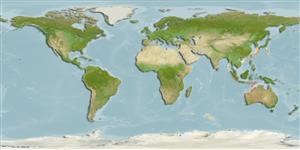Teleostei (teleosts) >
Ophidiiformes (Cusk eels) >
Carapidae (Pearlfishes) > Pyramodontinae
Etymology: Pyramodon: Greek, pyramis = pyramid + Greek, odous = teeth (Ref. 45335).
Eponymy: The etymology says that the binomial is in honour of “…two mature women who supported and endured this project.” It is not stated, but we presume that the two women, both named Linda, are the authors’ partners. (Ref. 128868), visit book page.
Environment: milieu / climate zone / depth range / distribution range
Ecology
Marine; bathydemersal; depth range 250 - 385 m (Ref. 34024). Deep-water
Western Pacific: Japan to northern Australia.
Size / Weight / Age
Maturity: Lm ? range ? - ? cm
Max length : 36.0 cm TL male/unsexed; (Ref. 6347)
Eel-like, moderate to relatively deep body depth; a large single vomerine fang; pelvic fin rays present; swim bladder large, filling visceral cavity and extending past anus; dorsal and anal fin radials robust and elongate; dorsal fin anteriad or directly over anal fin origin; lacking rockerbone, cardiform teeth, and intrinsic swim bladder constrictions or tunic ridges (Ref. 34024). Margins of dorsal and anal fins edged in black over entire length; head and body generally unpigmented (Ref. 34024).
Uncommon species (Ref. 34024).
Life cycle and mating behavior
Maturity | Reproduction | Spawning | Eggs | Fecundity | Larvae
Nielsen, J.G., D.M. Cohen, D.F. Markle and C.R. Robins, 1999. Ophidiiform fishes of the world (Order Ophidiiformes). An annotated and illustrated catalogue of pearlfishes, cusk-eels, brotulas and other ophidiiform fishes known to date. FAO Fish. Synop. 125(18):178p. Rome: FAO. (Ref. 34024)
IUCN Red List Status (Ref. 130435: Version 2024-1)
Threat to humans
Harmless
Human uses
Fisheries: of no interest
Tools
Special reports
Download XML
Internet sources
Estimates based on models
Preferred temperature (Ref.
123201): 10.9 - 12.9, mean 11.7 °C (based on 12 cells).
Phylogenetic diversity index (Ref.
82804): PD
50 = 0.5625 [Uniqueness, from 0.5 = low to 2.0 = high].
Bayesian length-weight: a=0.00102 (0.00046 - 0.00225), b=3.06 (2.88 - 3.24), in cm total length, based on all LWR estimates for this body shape (Ref.
93245).
Trophic level (Ref.
69278): 3.8 ±0.5 se; based on size and trophs of closest relatives
Fishing Vulnerability (Ref.
59153): Low to moderate vulnerability (26 of 100).
